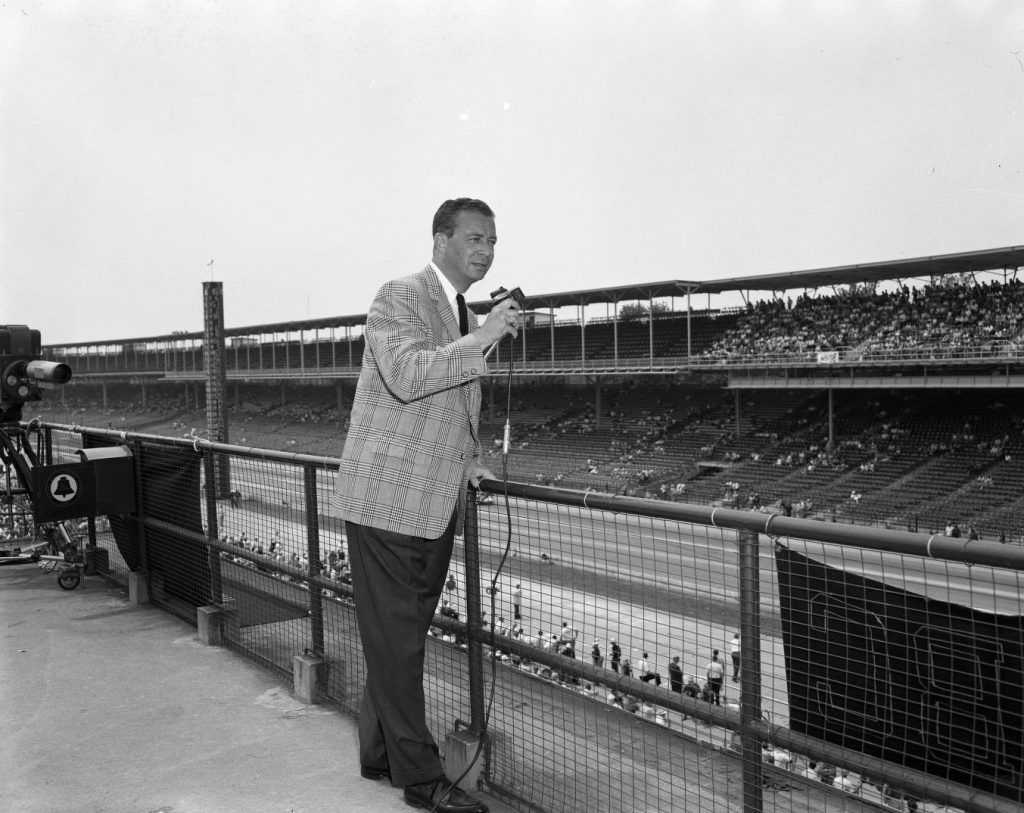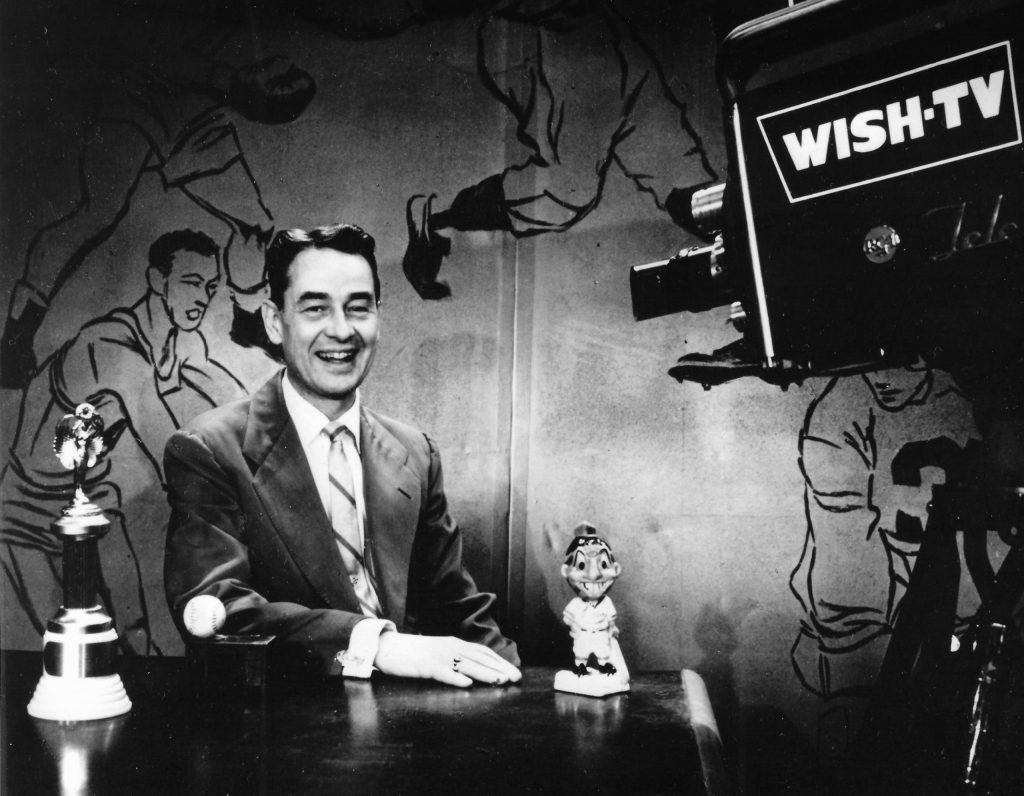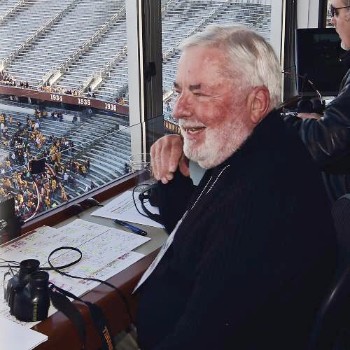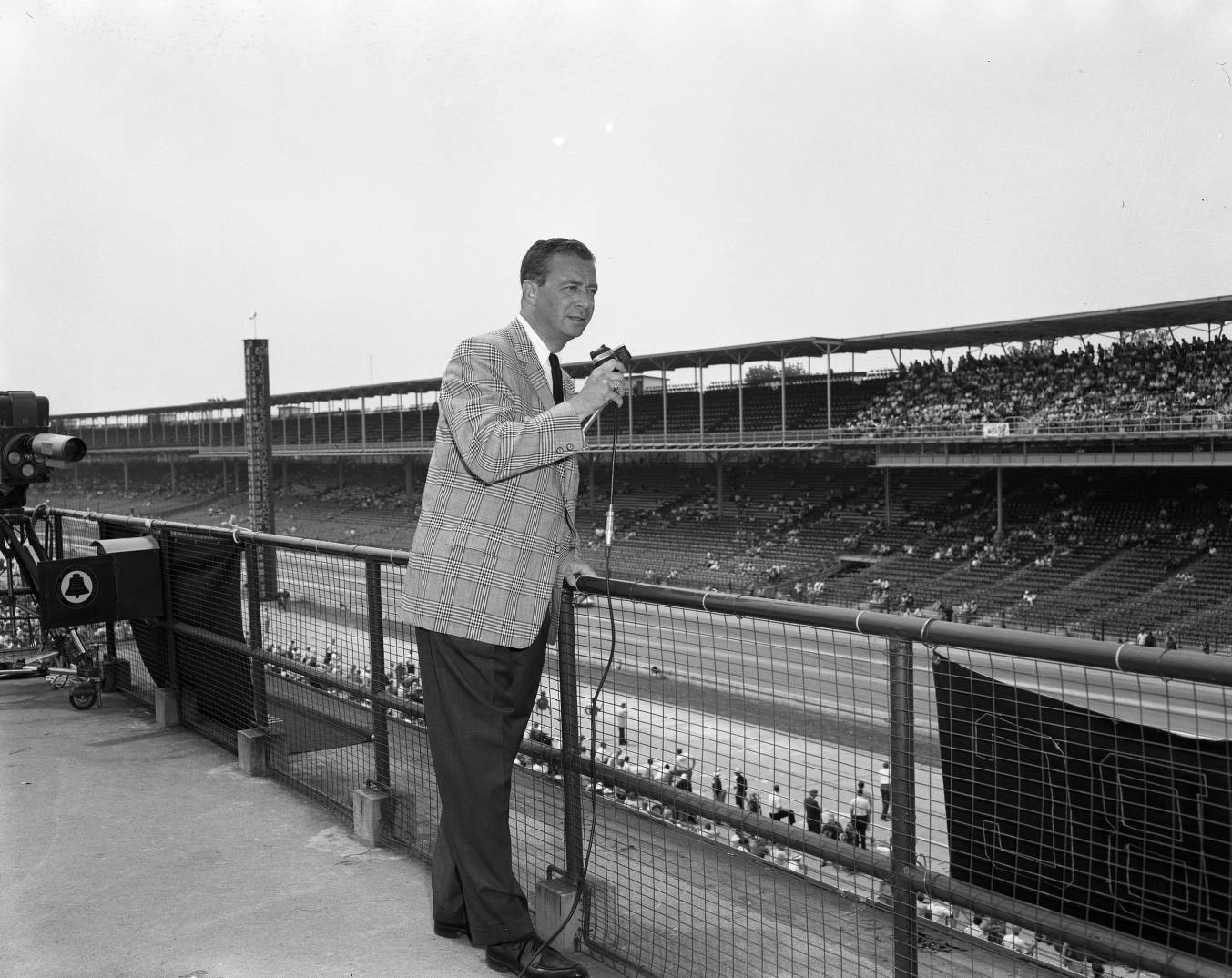Indianapolis broadcasting and sports have been linked since the early 1920s. In 1922 stations and broadcast reports on the , while the finals of the Boys’ Basket-ball Tourney were first broadcast by an Indianapolis station in 1925. College and professional sports teams became the focus of live coverage in the late 1930s.
In 1946 Mutual Radio Network began exclusive live reports on race day from the , anchored by the network’s Bill Slater. When illness kept Slater off the broadcast in 1951, personality became chief announcer. The Speedway and WIBC radio created the in 1952; Collins remained as chief announcer, with announcers from other Indianapolis stations reporting from various positions around the track. Collins continued as the “Voice of the 500” until he died in 1977. Paul Page (1977-1987, 2014-2015), Lou Palmer (1988-1989), (1990-1998), Mike King (1999-2013), and Mark Jaynes (2016-) have succeeded Collins as chief announcer for the 4 ½-hour broadcast.

WFBM-TV, Channel 6 (see ), used the race as the focal point of the station’s first day on the air in 1949, televising the race in its entirety. The station also carried the rain-shortened race in 1950, but it was 1964 before the race again was telecast live. That year WFBM produced the closed circuit broadcast made available in theaters nationwide. Channel 13 provided reports to ABC’s “Wide World of Sports” in the early 1960s; in 1965 the network began its coverage on “Wide World.” In 1971 ABC Sports televised an edited version of the race in prime time on Memorial Day. In 1986 the network signed a deal to carry the race live, and in 1988 Paul Page joined ABC Sports and became anchor for the telecast.
The IHSAA Boys’ Basketball Tourney began its relationship with local radio in 1925. Brothers Blythe and Thomas Hendricks broadcast the finals from the State Fairgrounds Exposition Building on WFBM. From the 1940s into the middle 1960s, WFBM, WIRE, and WIBC all carried tourney games from Butler Fieldhouse (see ). The tournament first came to television (Channel 6) in 1951. The telecasts moved to Channel 4 in 1976 under a new television rights arrangement with the IHSAA.
The city’s oldest professional sport is minor league baseball, and games have been broadcast since 1937 when Norm Perry Jr., son of the team owner, did play-by-play on WIRE. Indians’ broadcasts bounced between WIRE and WIBC over the next ten years before settling at radio in 1948. Announcer became a fixture behind the WISH microphone, broadcasting Indians’ games until 1956 when he left the station. succeeded Walton, handling the broadcasts through the 1960 season. In 1963 Walton returned for one season of weekend play-by-play on his radio station, WIGO. He aired home games live and used teletype accounts of road games to recreate broadcasts. After two seasons off the air, the Indians returned to local radio from 1966 to 1971 on WGEE-FM; in 1973 the broadcasts began on a string of suburban FM stations. Brooklyn native Howard Kellman has done play-by-play since 1974, often assisted by Tom Akins, timpanist for the . When the Indians’ broadcasts moved to in 1993 it marked the first time in 23 years the games had been heard on an Indianapolis radio station. Local television coverage of the Indians has been limited. Channel 6 carried the games in 1949 and the early 1950s, while Channel 4, Channel 6, and Channel 8 telecasted games in the early 1960s. Only a few isolated games have been carried by Channel 4 since then.

Professional basketball broadcasts date from the early 1950s. Luke Walton was the play-by-play voice of the Indianapolis Olympians, the city’s entry into the National Basketball Association (NBA) from 1949 to 1953. Pro basketball did not return to the city until 1967 when the became charter members of the American Basketball Association (ABA). WIRE radio carried Pacers’ games from 1967 to 1972 with Jerry Baker, a former air personality on , doing the broadcasts. WIBC secured radio rights in 1972, with Joe McConnell taking over announcing duties. McConnell broadcast the team’s last four seasons in the ABA and first in the NBA (1976-1977) before Bob Lamey became WIBC’s play-by-play voice for seven seasons. Jerry Gross replaced Lamey in 1984. WIRE regained broadcast rights in 1985; Greg Papa did the games. When the broadcasts returned to WIBC in 1986, Greg Lucas and then, Mike Inglis were announcers. Since 1988 Mark Boyle has been the voice of the Pacers, first on WIBC, and since 1989 on WNDE. Channel 13 was the first station to telecast Indiana Pacers games; Channel 4 and Channel 59 (see ) also have handled television coverage, with Channel 4 the team’s TV home for most seasons. The Pacers and Channel 4 tried a different approach in 1974 when a former local sportscaster, Larry Atkinson, was teamed with Phyllis Ackerman, an Indianapolis woman with no broadcasting experience. Reaction to a female basketball announcer was mixed, but the station did not renew her one-year contract.
Major league had a short stint in Indianapolis with the Indianapolis Racers of the World Hockey Association. WIBC broadcast their games, with Bob Lamey announcing from 1974 through 1977. When Lamey took over Pacers’ broadcasts in 1977, Mike Fornes became the station’s hockey announcer, a job he handled until the Racers folded early the next season.

When the National Football League’s Baltimore Colts (see ) moved to Indianapolis in 1984, WIBC obtained local radio rights. Jerry Baker did play-by-play of the team’s first preseason game, but Bob Lamey was the principal announcer when the season started and broadcast the team’s first eight seasons. In 1992 the Colts turned over their local radio and television to Sports Marketing Corp. of Cleveland. That group selected WFBQ-WNDE as the new radio home of the Colts, marking the first time in Indianapolis that FM was the principal outlet for one of the city’s professional sports teams. Joe McConnell returned to the city as play-by-play announcer, assisted by former Colts linebacker Barry Krause.
The national radio and television networks also broadcast sporting events from Indianapolis. Mutual, NBC, and CBS Radio carried reports from the Indianapolis Motor Speedway in the 1930s; the earliest national telecast from the city was a welterweight championship bout at the Coliseum in 1952. ABC-TV has been a fixture at the Indianapolis 500 since 1965 and carried the first stock car race in 1994. ABC also has aired figure skating, track and field, , and from Indianapolis, as well as the city’s first NFL “Monday Night Football” game on Halloween, 1988. CBS has televised NFL games from the city and telecast the in 1987 and the 1991 PGA Golf Championship. The network also carried two basketball leagues’ All-Star games from Indianapolis; the ABA game in the Coliseum in 1970 was that league’s first national telecast, while the NBA game in 1985 was televised from the . CBS also broadcast the NCAA Men’s Basketball Final Four (see ) from the Dome in 1991. NBC was on hand in 1980 to televise the NCAA Final Four from Market Square Arena, tennis from the Sports Center, and NFL football.
*Note: This entry is from the original print edition of the Encyclopedia of Indianapolis (1994). We seek an individual with knowledge of this topic to update this entry.

Help improve this entry
Contribute information, offer corrections, suggest images.
You can also recommend new entries related to this topic.
